Pros and Cons of USA-China Trade War and Protectionist Policy
VerifiedAdded on 2023/06/03
|11
|3273
|371
AI Summary
This report investigates the pros and cons of such a policy in the context of a globalized world as well as the comparative advantages that both the countries have currently. It also assess the impact on businesses in USA and China.
Contribute Materials
Your contribution can guide someone’s learning journey. Share your
documents today.

Cover Page
Secure Best Marks with AI Grader
Need help grading? Try our AI Grader for instant feedback on your assignments.
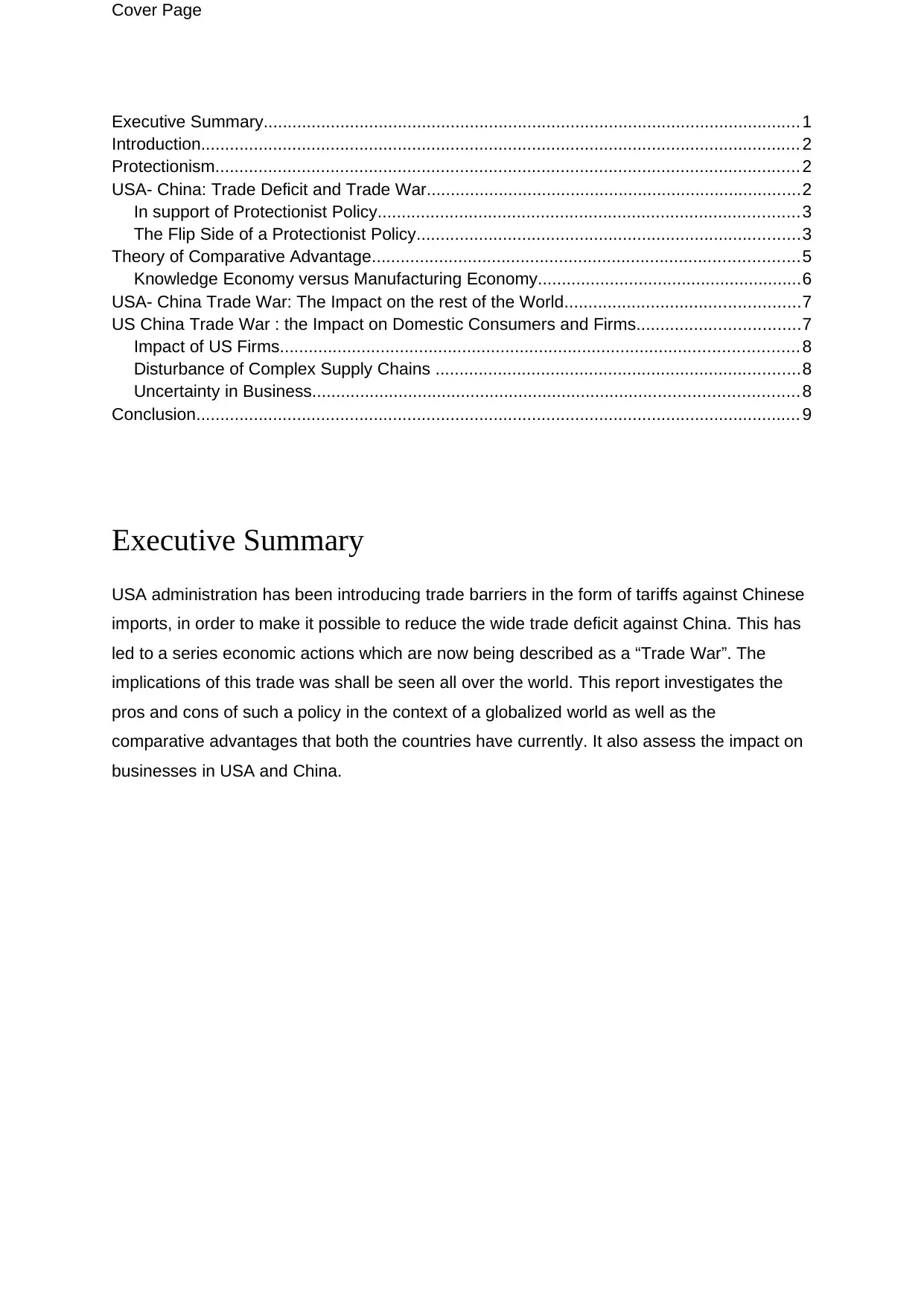
Cover Page
Executive Summary................................................................................................................ 1
Introduction............................................................................................................................. 2
Protectionism.......................................................................................................................... 2
USA- China: Trade Deficit and Trade War..............................................................................2
In support of Protectionist Policy........................................................................................3
The Flip Side of a Protectionist Policy................................................................................3
Theory of Comparative Advantage.........................................................................................5
Knowledge Economy versus Manufacturing Economy.......................................................6
USA- China Trade War: The Impact on the rest of the World.................................................7
US China Trade War : the Impact on Domestic Consumers and Firms..................................7
Impact of US Firms............................................................................................................ 8
Disturbance of Complex Supply Chains ............................................................................8
Uncertainty in Business.....................................................................................................8
Conclusion.............................................................................................................................. 9
Executive Summary
USA administration has been introducing trade barriers in the form of tariffs against Chinese
imports, in order to make it possible to reduce the wide trade deficit against China. This has
led to a series economic actions which are now being described as a “Trade War”. The
implications of this trade was shall be seen all over the world. This report investigates the
pros and cons of such a policy in the context of a globalized world as well as the
comparative advantages that both the countries have currently. It also assess the impact on
businesses in USA and China.
Executive Summary................................................................................................................ 1
Introduction............................................................................................................................. 2
Protectionism.......................................................................................................................... 2
USA- China: Trade Deficit and Trade War..............................................................................2
In support of Protectionist Policy........................................................................................3
The Flip Side of a Protectionist Policy................................................................................3
Theory of Comparative Advantage.........................................................................................5
Knowledge Economy versus Manufacturing Economy.......................................................6
USA- China Trade War: The Impact on the rest of the World.................................................7
US China Trade War : the Impact on Domestic Consumers and Firms..................................7
Impact of US Firms............................................................................................................ 8
Disturbance of Complex Supply Chains ............................................................................8
Uncertainty in Business.....................................................................................................8
Conclusion.............................................................................................................................. 9
Executive Summary
USA administration has been introducing trade barriers in the form of tariffs against Chinese
imports, in order to make it possible to reduce the wide trade deficit against China. This has
led to a series economic actions which are now being described as a “Trade War”. The
implications of this trade was shall be seen all over the world. This report investigates the
pros and cons of such a policy in the context of a globalized world as well as the
comparative advantages that both the countries have currently. It also assess the impact on
businesses in USA and China.
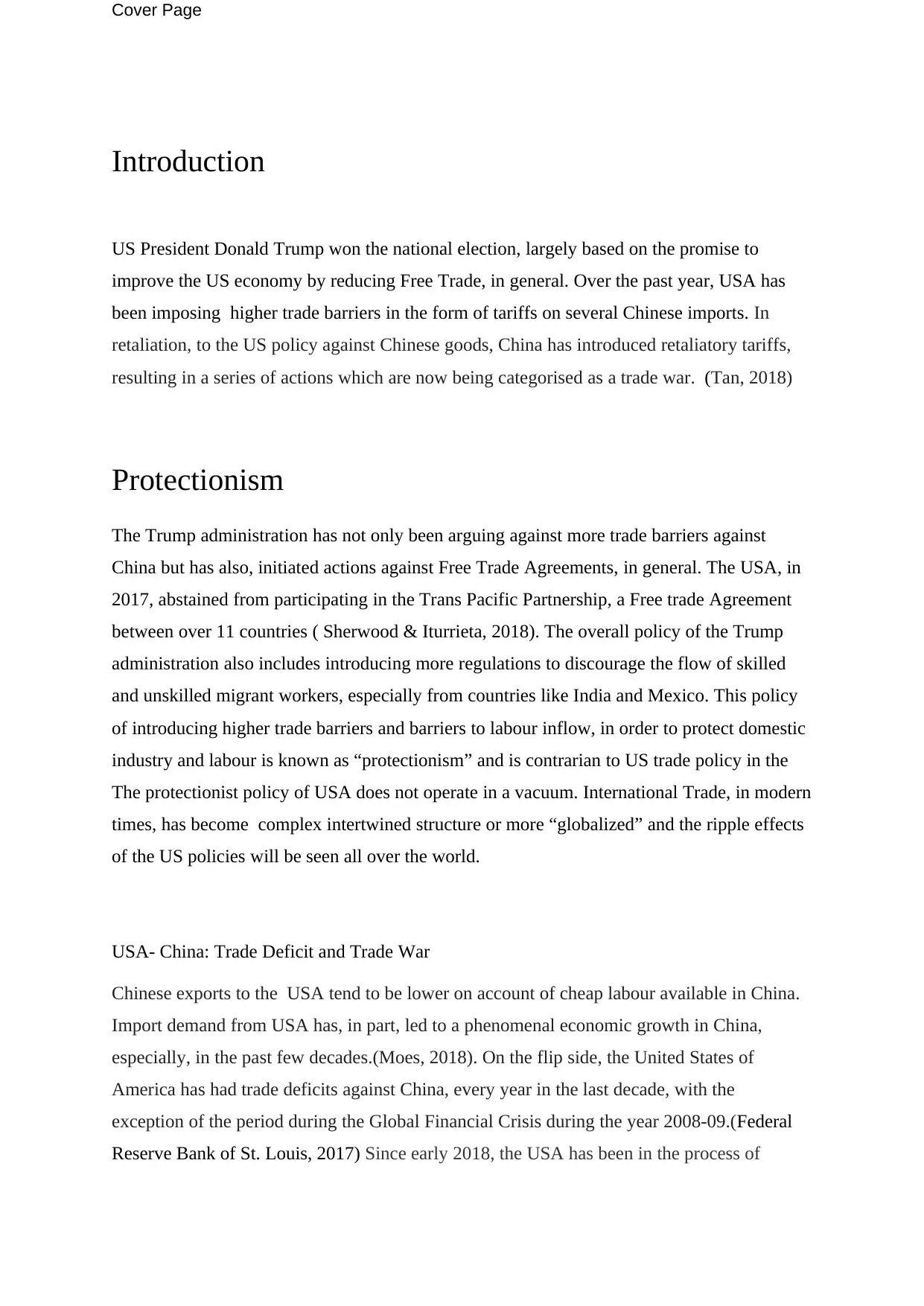
Cover Page
Introduction
US President Donald Trump won the national election, largely based on the promise to
improve the US economy by reducing Free Trade, in general. Over the past year, USA has
been imposing higher trade barriers in the form of tariffs on several Chinese imports. In
retaliation, to the US policy against Chinese goods, China has introduced retaliatory tariffs,
resulting in a series of actions which are now being categorised as a trade war. (Tan, 2018)
Protectionism
The Trump administration has not only been arguing against more trade barriers against
China but has also, initiated actions against Free Trade Agreements, in general. The USA, in
2017, abstained from participating in the Trans Pacific Partnership, a Free trade Agreement
between over 11 countries ( Sherwood & Iturrieta, 2018). The overall policy of the Trump
administration also includes introducing more regulations to discourage the flow of skilled
and unskilled migrant workers, especially from countries like India and Mexico. This policy
of introducing higher trade barriers and barriers to labour inflow, in order to protect domestic
industry and labour is known as “protectionism” and is contrarian to US trade policy in the
The protectionist policy of USA does not operate in a vacuum. International Trade, in modern
times, has become complex intertwined structure or more “globalized” and the ripple effects
of the US policies will be seen all over the world.
USA- China: Trade Deficit and Trade War
Chinese exports to the USA tend to be lower on account of cheap labour available in China.
Import demand from USA has, in part, led to a phenomenal economic growth in China,
especially, in the past few decades.(Moes, 2018). On the flip side, the United States of
America has had trade deficits against China, every year in the last decade, with the
exception of the period during the Global Financial Crisis during the year 2008-09.(Federal
Reserve Bank of St. Louis, 2017) Since early 2018, the USA has been in the process of
Introduction
US President Donald Trump won the national election, largely based on the promise to
improve the US economy by reducing Free Trade, in general. Over the past year, USA has
been imposing higher trade barriers in the form of tariffs on several Chinese imports. In
retaliation, to the US policy against Chinese goods, China has introduced retaliatory tariffs,
resulting in a series of actions which are now being categorised as a trade war. (Tan, 2018)
Protectionism
The Trump administration has not only been arguing against more trade barriers against
China but has also, initiated actions against Free Trade Agreements, in general. The USA, in
2017, abstained from participating in the Trans Pacific Partnership, a Free trade Agreement
between over 11 countries ( Sherwood & Iturrieta, 2018). The overall policy of the Trump
administration also includes introducing more regulations to discourage the flow of skilled
and unskilled migrant workers, especially from countries like India and Mexico. This policy
of introducing higher trade barriers and barriers to labour inflow, in order to protect domestic
industry and labour is known as “protectionism” and is contrarian to US trade policy in the
The protectionist policy of USA does not operate in a vacuum. International Trade, in modern
times, has become complex intertwined structure or more “globalized” and the ripple effects
of the US policies will be seen all over the world.
USA- China: Trade Deficit and Trade War
Chinese exports to the USA tend to be lower on account of cheap labour available in China.
Import demand from USA has, in part, led to a phenomenal economic growth in China,
especially, in the past few decades.(Moes, 2018). On the flip side, the United States of
America has had trade deficits against China, every year in the last decade, with the
exception of the period during the Global Financial Crisis during the year 2008-09.(Federal
Reserve Bank of St. Louis, 2017) Since early 2018, the USA has been in the process of
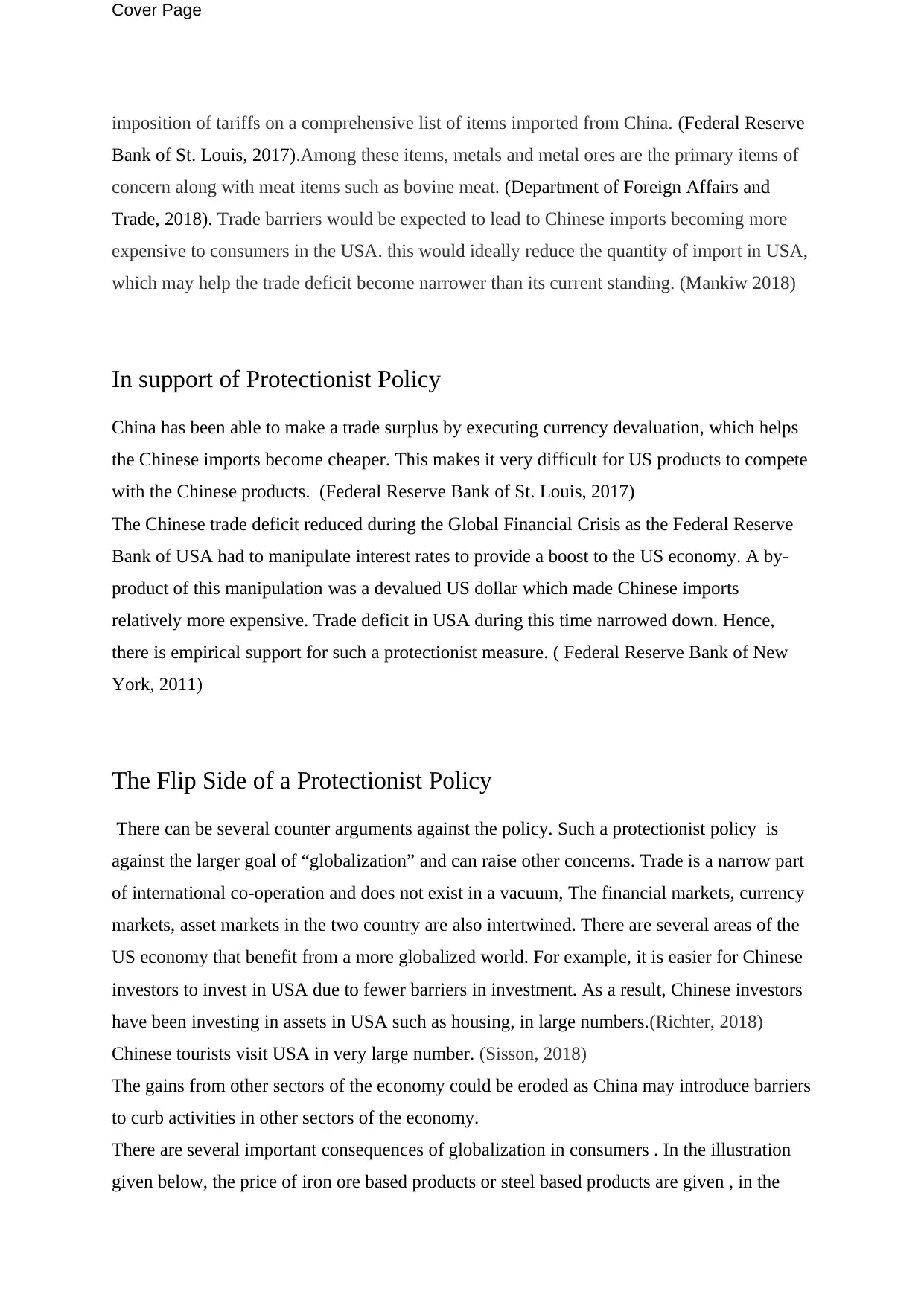
Cover Page
imposition of tariffs on a comprehensive list of items imported from China. (Federal Reserve
Bank of St. Louis, 2017).Among these items, metals and metal ores are the primary items of
concern along with meat items such as bovine meat. (Department of Foreign Affairs and
Trade, 2018). Trade barriers would be expected to lead to Chinese imports becoming more
expensive to consumers in the USA. this would ideally reduce the quantity of import in USA,
which may help the trade deficit become narrower than its current standing. (Mankiw 2018)
In support of Protectionist Policy
China has been able to make a trade surplus by executing currency devaluation, which helps
the Chinese imports become cheaper. This makes it very difficult for US products to compete
with the Chinese products. (Federal Reserve Bank of St. Louis, 2017)
The Chinese trade deficit reduced during the Global Financial Crisis as the Federal Reserve
Bank of USA had to manipulate interest rates to provide a boost to the US economy. A by-
product of this manipulation was a devalued US dollar which made Chinese imports
relatively more expensive. Trade deficit in USA during this time narrowed down. Hence,
there is empirical support for such a protectionist measure. ( Federal Reserve Bank of New
York, 2011)
The Flip Side of a Protectionist Policy
There can be several counter arguments against the policy. Such a protectionist policy is
against the larger goal of “globalization” and can raise other concerns. Trade is a narrow part
of international co-operation and does not exist in a vacuum, The financial markets, currency
markets, asset markets in the two country are also intertwined. There are several areas of the
US economy that benefit from a more globalized world. For example, it is easier for Chinese
investors to invest in USA due to fewer barriers in investment. As a result, Chinese investors
have been investing in assets in USA such as housing, in large numbers.(Richter, 2018)
Chinese tourists visit USA in very large number. (Sisson, 2018)
The gains from other sectors of the economy could be eroded as China may introduce barriers
to curb activities in other sectors of the economy.
There are several important consequences of globalization in consumers . In the illustration
given below, the price of iron ore based products or steel based products are given , in the
imposition of tariffs on a comprehensive list of items imported from China. (Federal Reserve
Bank of St. Louis, 2017).Among these items, metals and metal ores are the primary items of
concern along with meat items such as bovine meat. (Department of Foreign Affairs and
Trade, 2018). Trade barriers would be expected to lead to Chinese imports becoming more
expensive to consumers in the USA. this would ideally reduce the quantity of import in USA,
which may help the trade deficit become narrower than its current standing. (Mankiw 2018)
In support of Protectionist Policy
China has been able to make a trade surplus by executing currency devaluation, which helps
the Chinese imports become cheaper. This makes it very difficult for US products to compete
with the Chinese products. (Federal Reserve Bank of St. Louis, 2017)
The Chinese trade deficit reduced during the Global Financial Crisis as the Federal Reserve
Bank of USA had to manipulate interest rates to provide a boost to the US economy. A by-
product of this manipulation was a devalued US dollar which made Chinese imports
relatively more expensive. Trade deficit in USA during this time narrowed down. Hence,
there is empirical support for such a protectionist measure. ( Federal Reserve Bank of New
York, 2011)
The Flip Side of a Protectionist Policy
There can be several counter arguments against the policy. Such a protectionist policy is
against the larger goal of “globalization” and can raise other concerns. Trade is a narrow part
of international co-operation and does not exist in a vacuum, The financial markets, currency
markets, asset markets in the two country are also intertwined. There are several areas of the
US economy that benefit from a more globalized world. For example, it is easier for Chinese
investors to invest in USA due to fewer barriers in investment. As a result, Chinese investors
have been investing in assets in USA such as housing, in large numbers.(Richter, 2018)
Chinese tourists visit USA in very large number. (Sisson, 2018)
The gains from other sectors of the economy could be eroded as China may introduce barriers
to curb activities in other sectors of the economy.
There are several important consequences of globalization in consumers . In the illustration
given below, the price of iron ore based products or steel based products are given , in the
Secure Best Marks with AI Grader
Need help grading? Try our AI Grader for instant feedback on your assignments.

Cover Page
absence of trade with China and with trade with China. China, steel products importa make
reduce the price of steel based goods in the USA markets.
Illustration 1 : Iron Ore exports , with Free Trade and in the absence of Free Trade
with China
Impact on consumer
One of the most important arguments for Free Trade is that it provides consumers with
choice: Consumer have a wide variety of goods. Additionally , in case of free Trade,
consumers can choose the least expensive good available to them over the more expensive
good available from the domestic market. This is known as “consumer surplus”. In the
absence of Free Trade, there is a loss of consumer surplus and a “deadweight loss”. In the
above diagram, the loss of consumer surplus is depicted by triangle “bcf”. (Cartwright, 2009)
Impact of firms
Firms that import Chinese products will either have to pass on the increased prices to
consumers or bear the costs themselves by reducing their profit margins. If the firms bear the
absence of trade with China and with trade with China. China, steel products importa make
reduce the price of steel based goods in the USA markets.
Illustration 1 : Iron Ore exports , with Free Trade and in the absence of Free Trade
with China
Impact on consumer
One of the most important arguments for Free Trade is that it provides consumers with
choice: Consumer have a wide variety of goods. Additionally , in case of free Trade,
consumers can choose the least expensive good available to them over the more expensive
good available from the domestic market. This is known as “consumer surplus”. In the
absence of Free Trade, there is a loss of consumer surplus and a “deadweight loss”. In the
above diagram, the loss of consumer surplus is depicted by triangle “bcf”. (Cartwright, 2009)
Impact of firms
Firms that import Chinese products will either have to pass on the increased prices to
consumers or bear the costs themselves by reducing their profit margins. If the firms bear the
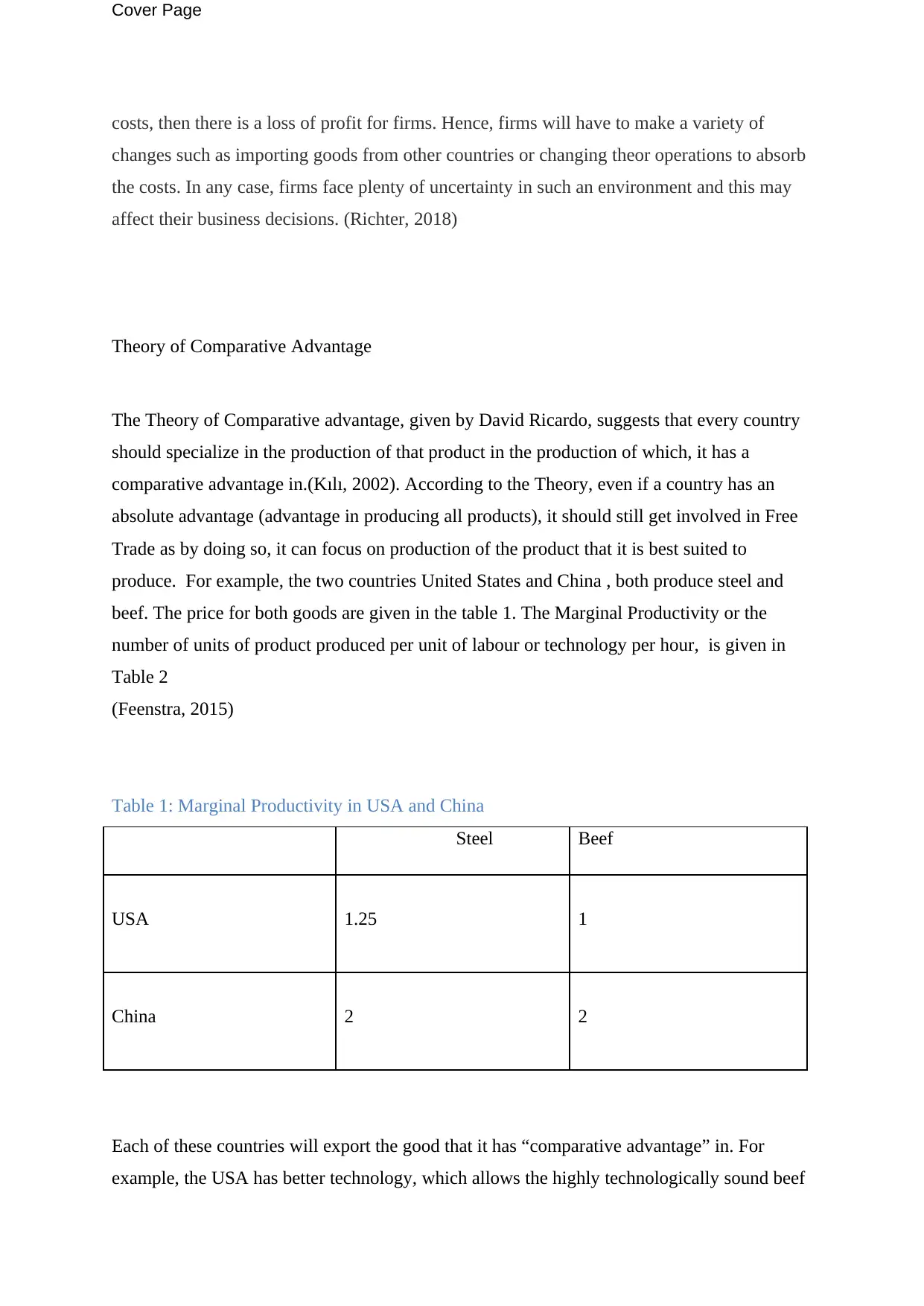
Cover Page
costs, then there is a loss of profit for firms. Hence, firms will have to make a variety of
changes such as importing goods from other countries or changing theor operations to absorb
the costs. In any case, firms face plenty of uncertainty in such an environment and this may
affect their business decisions. (Richter, 2018)
Theory of Comparative Advantage
The Theory of Comparative advantage, given by David Ricardo, suggests that every country
should specialize in the production of that product in the production of which, it has a
comparative advantage in.(Kılı, 2002). According to the Theory, even if a country has an
absolute advantage (advantage in producing all products), it should still get involved in Free
Trade as by doing so, it can focus on production of the product that it is best suited to
produce. For example, the two countries United States and China , both produce steel and
beef. The price for both goods are given in the table 1. The Marginal Productivity or the
number of units of product produced per unit of labour or technology per hour, is given in
Table 2
(Feenstra, 2015)
Table 1: Marginal Productivity in USA and China
Steel Beef
USA 1.25 1
China 2 2
Each of these countries will export the good that it has “comparative advantage” in. For
example, the USA has better technology, which allows the highly technologically sound beef
costs, then there is a loss of profit for firms. Hence, firms will have to make a variety of
changes such as importing goods from other countries or changing theor operations to absorb
the costs. In any case, firms face plenty of uncertainty in such an environment and this may
affect their business decisions. (Richter, 2018)
Theory of Comparative Advantage
The Theory of Comparative advantage, given by David Ricardo, suggests that every country
should specialize in the production of that product in the production of which, it has a
comparative advantage in.(Kılı, 2002). According to the Theory, even if a country has an
absolute advantage (advantage in producing all products), it should still get involved in Free
Trade as by doing so, it can focus on production of the product that it is best suited to
produce. For example, the two countries United States and China , both produce steel and
beef. The price for both goods are given in the table 1. The Marginal Productivity or the
number of units of product produced per unit of labour or technology per hour, is given in
Table 2
(Feenstra, 2015)
Table 1: Marginal Productivity in USA and China
Steel Beef
USA 1.25 1
China 2 2
Each of these countries will export the good that it has “comparative advantage” in. For
example, the USA has better technology, which allows the highly technologically sound beef
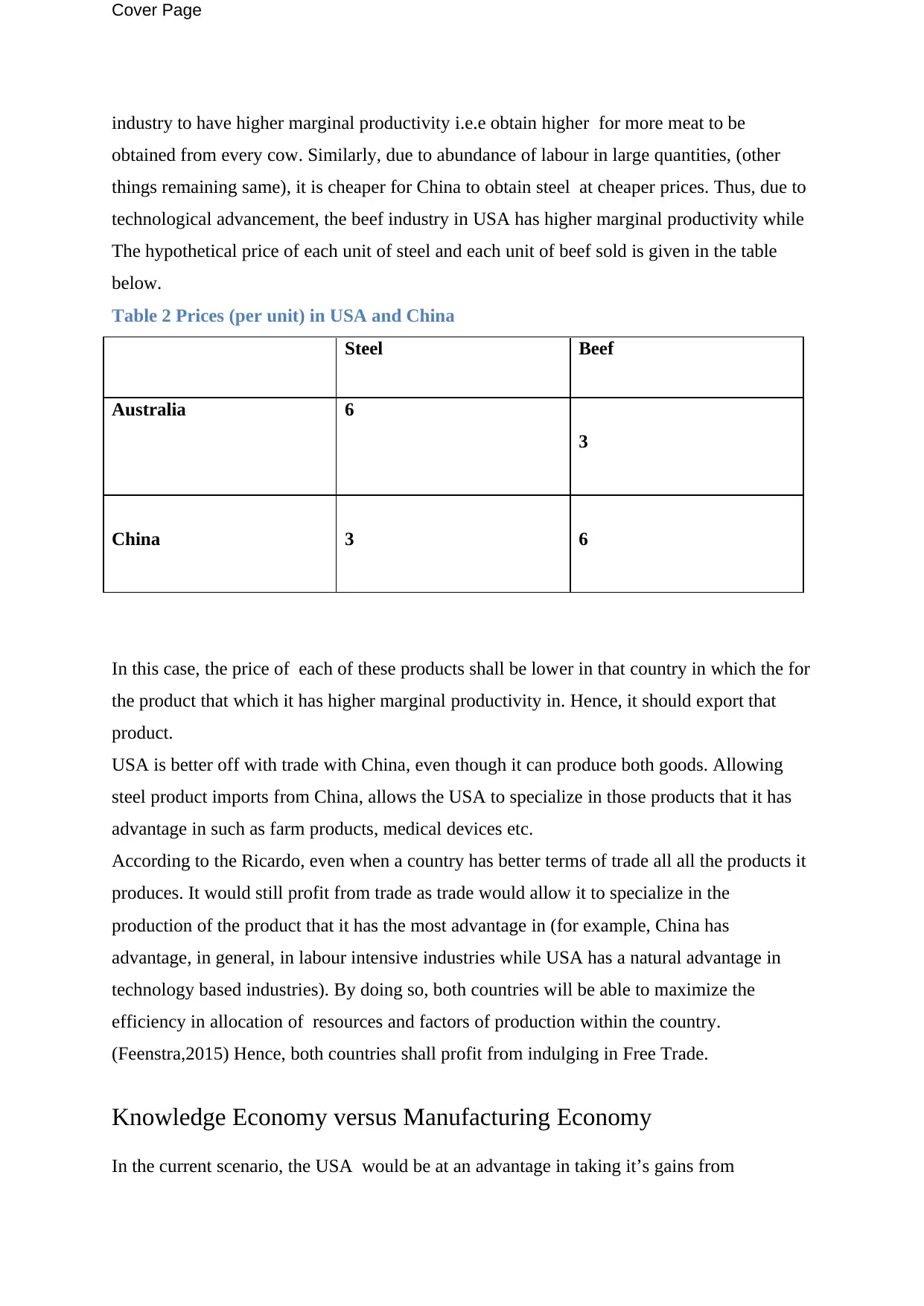
Cover Page
industry to have higher marginal productivity i.e.e obtain higher for more meat to be
obtained from every cow. Similarly, due to abundance of labour in large quantities, (other
things remaining same), it is cheaper for China to obtain steel at cheaper prices. Thus, due to
technological advancement, the beef industry in USA has higher marginal productivity while
The hypothetical price of each unit of steel and each unit of beef sold is given in the table
below.
Table 2 Prices (per unit) in USA and China
Steel Beef
Australia 6
3
China 3 6
In this case, the price of each of these products shall be lower in that country in which the for
the product that which it has higher marginal productivity in. Hence, it should export that
product.
USA is better off with trade with China, even though it can produce both goods. Allowing
steel product imports from China, allows the USA to specialize in those products that it has
advantage in such as farm products, medical devices etc.
According to the Ricardo, even when a country has better terms of trade all all the products it
produces. It would still profit from trade as trade would allow it to specialize in the
production of the product that it has the most advantage in (for example, China has
advantage, in general, in labour intensive industries while USA has a natural advantage in
technology based industries). By doing so, both countries will be able to maximize the
efficiency in allocation of resources and factors of production within the country.
(Feenstra,2015) Hence, both countries shall profit from indulging in Free Trade.
Knowledge Economy versus Manufacturing Economy
In the current scenario, the USA would be at an advantage in taking it’s gains from
industry to have higher marginal productivity i.e.e obtain higher for more meat to be
obtained from every cow. Similarly, due to abundance of labour in large quantities, (other
things remaining same), it is cheaper for China to obtain steel at cheaper prices. Thus, due to
technological advancement, the beef industry in USA has higher marginal productivity while
The hypothetical price of each unit of steel and each unit of beef sold is given in the table
below.
Table 2 Prices (per unit) in USA and China
Steel Beef
Australia 6
3
China 3 6
In this case, the price of each of these products shall be lower in that country in which the for
the product that which it has higher marginal productivity in. Hence, it should export that
product.
USA is better off with trade with China, even though it can produce both goods. Allowing
steel product imports from China, allows the USA to specialize in those products that it has
advantage in such as farm products, medical devices etc.
According to the Ricardo, even when a country has better terms of trade all all the products it
produces. It would still profit from trade as trade would allow it to specialize in the
production of the product that it has the most advantage in (for example, China has
advantage, in general, in labour intensive industries while USA has a natural advantage in
technology based industries). By doing so, both countries will be able to maximize the
efficiency in allocation of resources and factors of production within the country.
(Feenstra,2015) Hence, both countries shall profit from indulging in Free Trade.
Knowledge Economy versus Manufacturing Economy
In the current scenario, the USA would be at an advantage in taking it’s gains from
Paraphrase This Document
Need a fresh take? Get an instant paraphrase of this document with our AI Paraphraser
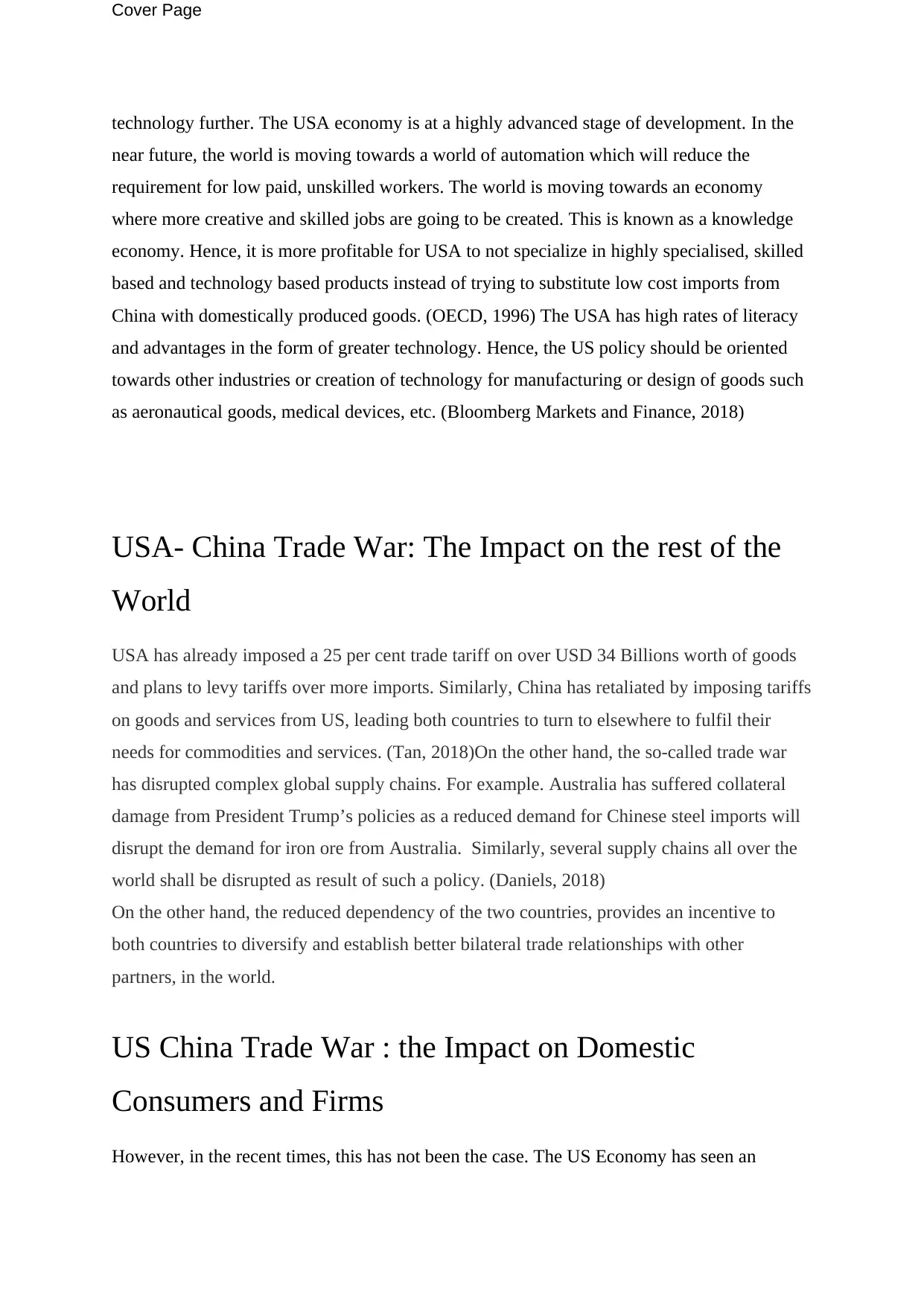
Cover Page
technology further. The USA economy is at a highly advanced stage of development. In the
near future, the world is moving towards a world of automation which will reduce the
requirement for low paid, unskilled workers. The world is moving towards an economy
where more creative and skilled jobs are going to be created. This is known as a knowledge
economy. Hence, it is more profitable for USA to not specialize in highly specialised, skilled
based and technology based products instead of trying to substitute low cost imports from
China with domestically produced goods. (OECD, 1996) The USA has high rates of literacy
and advantages in the form of greater technology. Hence, the US policy should be oriented
towards other industries or creation of technology for manufacturing or design of goods such
as aeronautical goods, medical devices, etc. (Bloomberg Markets and Finance, 2018)
USA- China Trade War: The Impact on the rest of the
World
USA has already imposed a 25 per cent trade tariff on over USD 34 Billions worth of goods
and plans to levy tariffs over more imports. Similarly, China has retaliated by imposing tariffs
on goods and services from US, leading both countries to turn to elsewhere to fulfil their
needs for commodities and services. (Tan, 2018)On the other hand, the so-called trade war
has disrupted complex global supply chains. For example. Australia has suffered collateral
damage from President Trump’s policies as a reduced demand for Chinese steel imports will
disrupt the demand for iron ore from Australia. Similarly, several supply chains all over the
world shall be disrupted as result of such a policy. (Daniels, 2018)
On the other hand, the reduced dependency of the two countries, provides an incentive to
both countries to diversify and establish better bilateral trade relationships with other
partners, in the world.
US China Trade War : the Impact on Domestic
Consumers and Firms
However, in the recent times, this has not been the case. The US Economy has seen an
technology further. The USA economy is at a highly advanced stage of development. In the
near future, the world is moving towards a world of automation which will reduce the
requirement for low paid, unskilled workers. The world is moving towards an economy
where more creative and skilled jobs are going to be created. This is known as a knowledge
economy. Hence, it is more profitable for USA to not specialize in highly specialised, skilled
based and technology based products instead of trying to substitute low cost imports from
China with domestically produced goods. (OECD, 1996) The USA has high rates of literacy
and advantages in the form of greater technology. Hence, the US policy should be oriented
towards other industries or creation of technology for manufacturing or design of goods such
as aeronautical goods, medical devices, etc. (Bloomberg Markets and Finance, 2018)
USA- China Trade War: The Impact on the rest of the
World
USA has already imposed a 25 per cent trade tariff on over USD 34 Billions worth of goods
and plans to levy tariffs over more imports. Similarly, China has retaliated by imposing tariffs
on goods and services from US, leading both countries to turn to elsewhere to fulfil their
needs for commodities and services. (Tan, 2018)On the other hand, the so-called trade war
has disrupted complex global supply chains. For example. Australia has suffered collateral
damage from President Trump’s policies as a reduced demand for Chinese steel imports will
disrupt the demand for iron ore from Australia. Similarly, several supply chains all over the
world shall be disrupted as result of such a policy. (Daniels, 2018)
On the other hand, the reduced dependency of the two countries, provides an incentive to
both countries to diversify and establish better bilateral trade relationships with other
partners, in the world.
US China Trade War : the Impact on Domestic
Consumers and Firms
However, in the recent times, this has not been the case. The US Economy has seen an
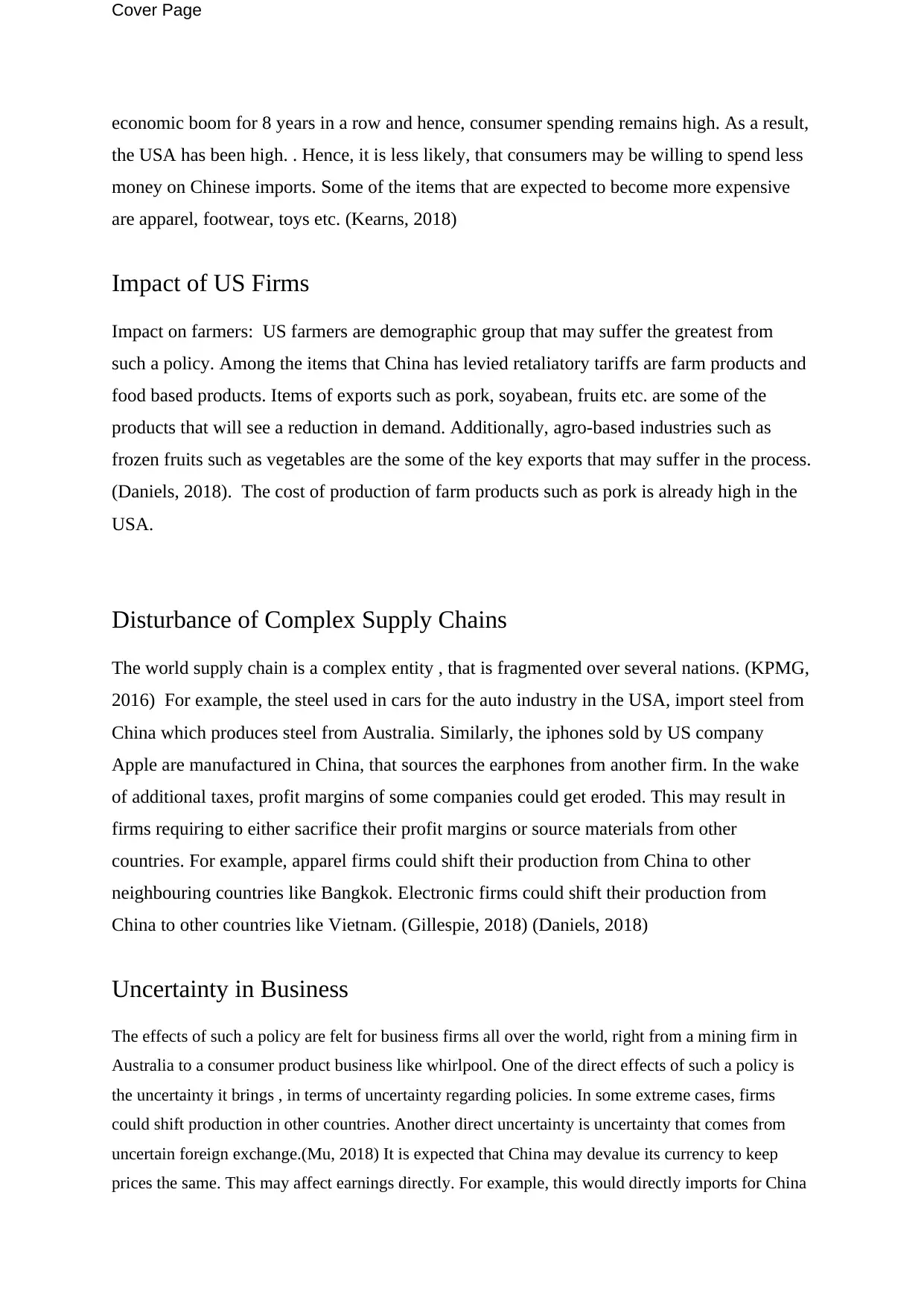
Cover Page
economic boom for 8 years in a row and hence, consumer spending remains high. As a result,
the USA has been high. . Hence, it is less likely, that consumers may be willing to spend less
money on Chinese imports. Some of the items that are expected to become more expensive
are apparel, footwear, toys etc. (Kearns, 2018)
Impact of US Firms
Impact on farmers: US farmers are demographic group that may suffer the greatest from
such a policy. Among the items that China has levied retaliatory tariffs are farm products and
food based products. Items of exports such as pork, soyabean, fruits etc. are some of the
products that will see a reduction in demand. Additionally, agro-based industries such as
frozen fruits such as vegetables are the some of the key exports that may suffer in the process.
(Daniels, 2018). The cost of production of farm products such as pork is already high in the
USA.
Disturbance of Complex Supply Chains
The world supply chain is a complex entity , that is fragmented over several nations. (KPMG,
2016) For example, the steel used in cars for the auto industry in the USA, import steel from
China which produces steel from Australia. Similarly, the iphones sold by US company
Apple are manufactured in China, that sources the earphones from another firm. In the wake
of additional taxes, profit margins of some companies could get eroded. This may result in
firms requiring to either sacrifice their profit margins or source materials from other
countries. For example, apparel firms could shift their production from China to other
neighbouring countries like Bangkok. Electronic firms could shift their production from
China to other countries like Vietnam. (Gillespie, 2018) (Daniels, 2018)
Uncertainty in Business
The effects of such a policy are felt for business firms all over the world, right from a mining firm in
Australia to a consumer product business like whirlpool. One of the direct effects of such a policy is
the uncertainty it brings , in terms of uncertainty regarding policies. In some extreme cases, firms
could shift production in other countries. Another direct uncertainty is uncertainty that comes from
uncertain foreign exchange.(Mu, 2018) It is expected that China may devalue its currency to keep
prices the same. This may affect earnings directly. For example, this would directly imports for China
economic boom for 8 years in a row and hence, consumer spending remains high. As a result,
the USA has been high. . Hence, it is less likely, that consumers may be willing to spend less
money on Chinese imports. Some of the items that are expected to become more expensive
are apparel, footwear, toys etc. (Kearns, 2018)
Impact of US Firms
Impact on farmers: US farmers are demographic group that may suffer the greatest from
such a policy. Among the items that China has levied retaliatory tariffs are farm products and
food based products. Items of exports such as pork, soyabean, fruits etc. are some of the
products that will see a reduction in demand. Additionally, agro-based industries such as
frozen fruits such as vegetables are the some of the key exports that may suffer in the process.
(Daniels, 2018). The cost of production of farm products such as pork is already high in the
USA.
Disturbance of Complex Supply Chains
The world supply chain is a complex entity , that is fragmented over several nations. (KPMG,
2016) For example, the steel used in cars for the auto industry in the USA, import steel from
China which produces steel from Australia. Similarly, the iphones sold by US company
Apple are manufactured in China, that sources the earphones from another firm. In the wake
of additional taxes, profit margins of some companies could get eroded. This may result in
firms requiring to either sacrifice their profit margins or source materials from other
countries. For example, apparel firms could shift their production from China to other
neighbouring countries like Bangkok. Electronic firms could shift their production from
China to other countries like Vietnam. (Gillespie, 2018) (Daniels, 2018)
Uncertainty in Business
The effects of such a policy are felt for business firms all over the world, right from a mining firm in
Australia to a consumer product business like whirlpool. One of the direct effects of such a policy is
the uncertainty it brings , in terms of uncertainty regarding policies. In some extreme cases, firms
could shift production in other countries. Another direct uncertainty is uncertainty that comes from
uncertain foreign exchange.(Mu, 2018) It is expected that China may devalue its currency to keep
prices the same. This may affect earnings directly. For example, this would directly imports for China
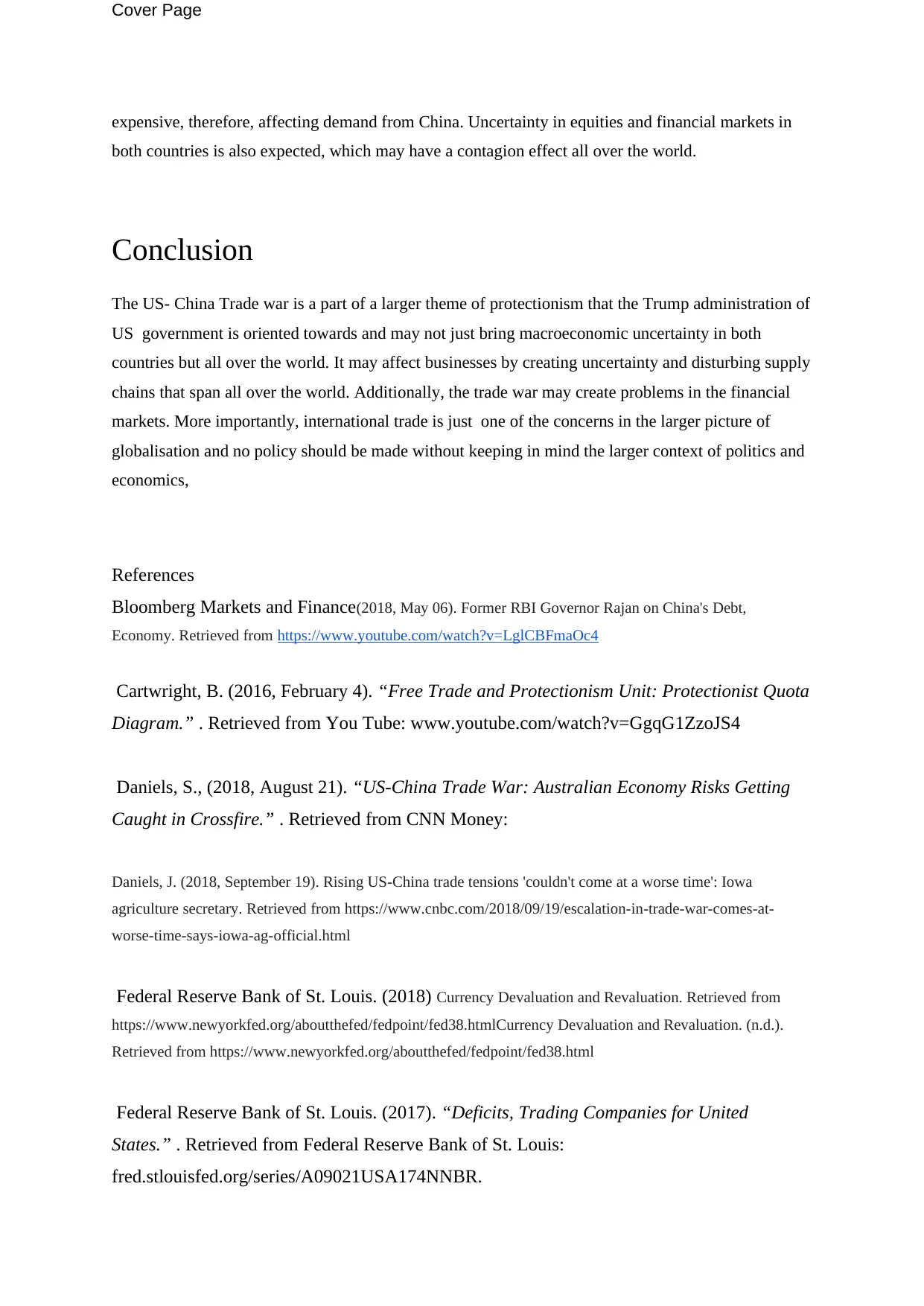
Cover Page
expensive, therefore, affecting demand from China. Uncertainty in equities and financial markets in
both countries is also expected, which may have a contagion effect all over the world.
Conclusion
The US- China Trade war is a part of a larger theme of protectionism that the Trump administration of
US government is oriented towards and may not just bring macroeconomic uncertainty in both
countries but all over the world. It may affect businesses by creating uncertainty and disturbing supply
chains that span all over the world. Additionally, the trade war may create problems in the financial
markets. More importantly, international trade is just one of the concerns in the larger picture of
globalisation and no policy should be made without keeping in mind the larger context of politics and
economics,
References
Bloomberg Markets and Finance(2018, May 06). Former RBI Governor Rajan on China's Debt,
Economy. Retrieved from https://www.youtube.com/watch?v=LglCBFmaOc4
Cartwright, B. (2016, February 4). “Free Trade and Protectionism Unit: Protectionist Quota
Diagram.” . Retrieved from You Tube: www.youtube.com/watch?v=GgqG1ZzoJS4
Daniels, S., (2018, August 21). “US-China Trade War: Australian Economy Risks Getting
Caught in Crossfire.” . Retrieved from CNN Money:
Daniels, J. (2018, September 19). Rising US-China trade tensions 'couldn't come at a worse time': Iowa
agriculture secretary. Retrieved from https://www.cnbc.com/2018/09/19/escalation-in-trade-war-comes-at-
worse-time-says-iowa-ag-official.html
Federal Reserve Bank of St. Louis. (2018) Currency Devaluation and Revaluation. Retrieved from
https://www.newyorkfed.org/aboutthefed/fedpoint/fed38.htmlCurrency Devaluation and Revaluation. (n.d.).
Retrieved from https://www.newyorkfed.org/aboutthefed/fedpoint/fed38.html
Federal Reserve Bank of St. Louis. (2017). “Deficits, Trading Companies for United
States.” . Retrieved from Federal Reserve Bank of St. Louis:
fred.stlouisfed.org/series/A09021USA174NNBR.
expensive, therefore, affecting demand from China. Uncertainty in equities and financial markets in
both countries is also expected, which may have a contagion effect all over the world.
Conclusion
The US- China Trade war is a part of a larger theme of protectionism that the Trump administration of
US government is oriented towards and may not just bring macroeconomic uncertainty in both
countries but all over the world. It may affect businesses by creating uncertainty and disturbing supply
chains that span all over the world. Additionally, the trade war may create problems in the financial
markets. More importantly, international trade is just one of the concerns in the larger picture of
globalisation and no policy should be made without keeping in mind the larger context of politics and
economics,
References
Bloomberg Markets and Finance(2018, May 06). Former RBI Governor Rajan on China's Debt,
Economy. Retrieved from https://www.youtube.com/watch?v=LglCBFmaOc4
Cartwright, B. (2016, February 4). “Free Trade and Protectionism Unit: Protectionist Quota
Diagram.” . Retrieved from You Tube: www.youtube.com/watch?v=GgqG1ZzoJS4
Daniels, S., (2018, August 21). “US-China Trade War: Australian Economy Risks Getting
Caught in Crossfire.” . Retrieved from CNN Money:
Daniels, J. (2018, September 19). Rising US-China trade tensions 'couldn't come at a worse time': Iowa
agriculture secretary. Retrieved from https://www.cnbc.com/2018/09/19/escalation-in-trade-war-comes-at-
worse-time-says-iowa-ag-official.html
Federal Reserve Bank of St. Louis. (2018) Currency Devaluation and Revaluation. Retrieved from
https://www.newyorkfed.org/aboutthefed/fedpoint/fed38.htmlCurrency Devaluation and Revaluation. (n.d.).
Retrieved from https://www.newyorkfed.org/aboutthefed/fedpoint/fed38.html
Federal Reserve Bank of St. Louis. (2017). “Deficits, Trading Companies for United
States.” . Retrieved from Federal Reserve Bank of St. Louis:
fred.stlouisfed.org/series/A09021USA174NNBR.
Secure Best Marks with AI Grader
Need help grading? Try our AI Grader for instant feedback on your assignments.
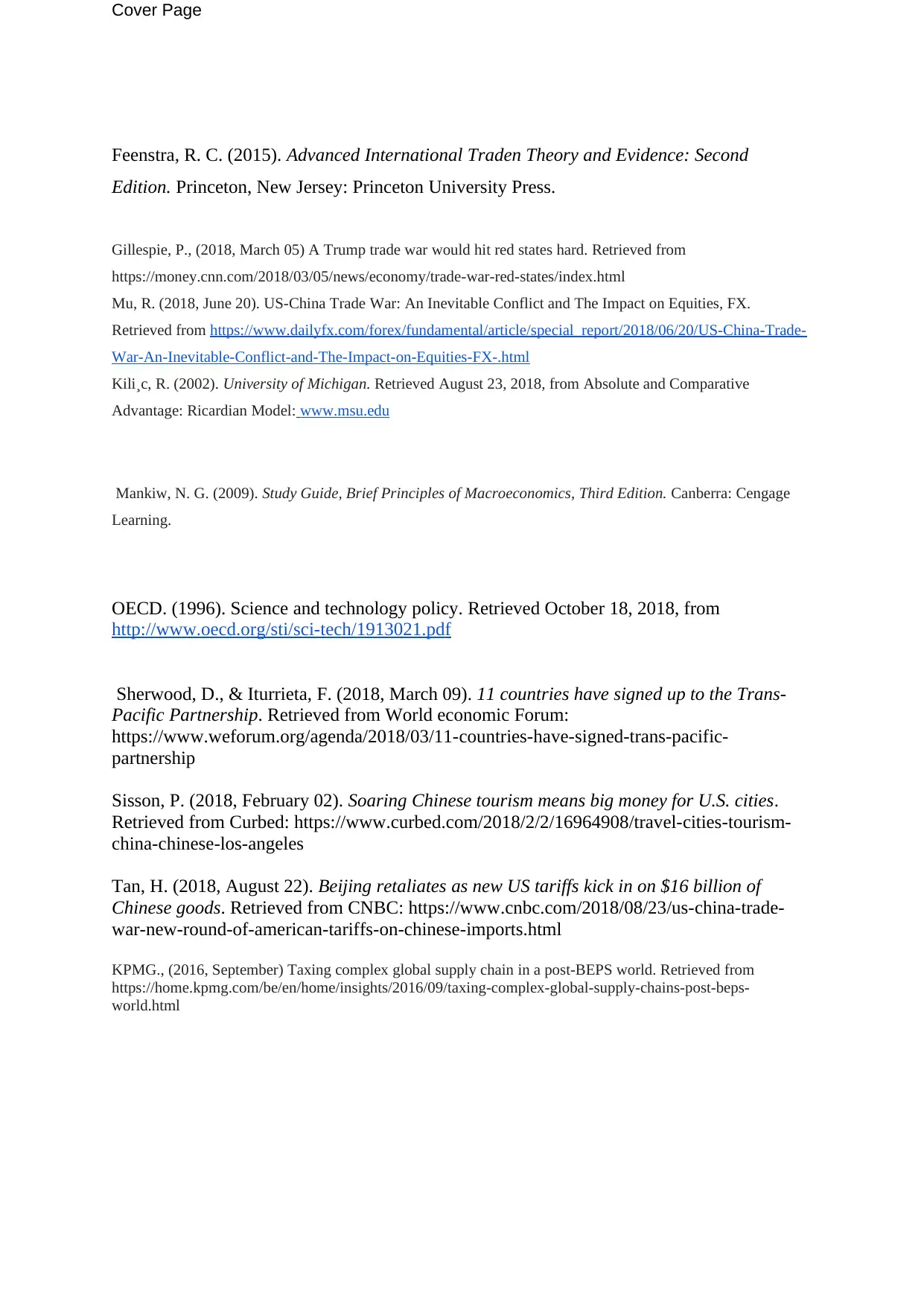
Cover Page
Feenstra, R. C. (2015). Advanced International Traden Theory and Evidence: Second
Edition. Princeton, New Jersey: Princeton University Press.
Gillespie, P., (2018, March 05) A Trump trade war would hit red states hard. Retrieved from
https://money.cnn.com/2018/03/05/news/economy/trade-war-red-states/index.html
Mu, R. (2018, June 20). US-China Trade War: An Inevitable Conflict and The Impact on Equities, FX.
Retrieved from https://www.dailyfx.com/forex/fundamental/article/special_report/2018/06/20/US-China-Trade-
War-An-Inevitable-Conflict-and-The-Impact-on-Equities-FX-.html
Kili¸c, R. (2002). University of Michigan. Retrieved August 23, 2018, from Absolute and Comparative
Advantage: Ricardian Model: www.msu.edu
Mankiw, N. G. (2009). Study Guide, Brief Principles of Macroeconomics, Third Edition. Canberra: Cengage
Learning.
OECD. (1996). Science and technology policy. Retrieved October 18, 2018, from
http://www.oecd.org/sti/sci-tech/1913021.pdf
Sherwood, D., & Iturrieta, F. (2018, March 09). 11 countries have signed up to the Trans-
Pacific Partnership. Retrieved from World economic Forum:
https://www.weforum.org/agenda/2018/03/11-countries-have-signed-trans-pacific-
partnership
Sisson, P. (2018, February 02). Soaring Chinese tourism means big money for U.S. cities.
Retrieved from Curbed: https://www.curbed.com/2018/2/2/16964908/travel-cities-tourism-
china-chinese-los-angeles
Tan, H. (2018, August 22). Beijing retaliates as new US tariffs kick in on $16 billion of
Chinese goods. Retrieved from CNBC: https://www.cnbc.com/2018/08/23/us-china-trade-
war-new-round-of-american-tariffs-on-chinese-imports.html
KPMG., (2016, September) Taxing complex global supply chain in a post-BEPS world. Retrieved from
https://home.kpmg.com/be/en/home/insights/2016/09/taxing-complex-global-supply-chains-post-beps-
world.html
Feenstra, R. C. (2015). Advanced International Traden Theory and Evidence: Second
Edition. Princeton, New Jersey: Princeton University Press.
Gillespie, P., (2018, March 05) A Trump trade war would hit red states hard. Retrieved from
https://money.cnn.com/2018/03/05/news/economy/trade-war-red-states/index.html
Mu, R. (2018, June 20). US-China Trade War: An Inevitable Conflict and The Impact on Equities, FX.
Retrieved from https://www.dailyfx.com/forex/fundamental/article/special_report/2018/06/20/US-China-Trade-
War-An-Inevitable-Conflict-and-The-Impact-on-Equities-FX-.html
Kili¸c, R. (2002). University of Michigan. Retrieved August 23, 2018, from Absolute and Comparative
Advantage: Ricardian Model: www.msu.edu
Mankiw, N. G. (2009). Study Guide, Brief Principles of Macroeconomics, Third Edition. Canberra: Cengage
Learning.
OECD. (1996). Science and technology policy. Retrieved October 18, 2018, from
http://www.oecd.org/sti/sci-tech/1913021.pdf
Sherwood, D., & Iturrieta, F. (2018, March 09). 11 countries have signed up to the Trans-
Pacific Partnership. Retrieved from World economic Forum:
https://www.weforum.org/agenda/2018/03/11-countries-have-signed-trans-pacific-
partnership
Sisson, P. (2018, February 02). Soaring Chinese tourism means big money for U.S. cities.
Retrieved from Curbed: https://www.curbed.com/2018/2/2/16964908/travel-cities-tourism-
china-chinese-los-angeles
Tan, H. (2018, August 22). Beijing retaliates as new US tariffs kick in on $16 billion of
Chinese goods. Retrieved from CNBC: https://www.cnbc.com/2018/08/23/us-china-trade-
war-new-round-of-american-tariffs-on-chinese-imports.html
KPMG., (2016, September) Taxing complex global supply chain in a post-BEPS world. Retrieved from
https://home.kpmg.com/be/en/home/insights/2016/09/taxing-complex-global-supply-chains-post-beps-
world.html
1 out of 11
Related Documents
Your All-in-One AI-Powered Toolkit for Academic Success.
+13062052269
info@desklib.com
Available 24*7 on WhatsApp / Email
![[object Object]](/_next/static/media/star-bottom.7253800d.svg)
Unlock your academic potential
© 2024 | Zucol Services PVT LTD | All rights reserved.





